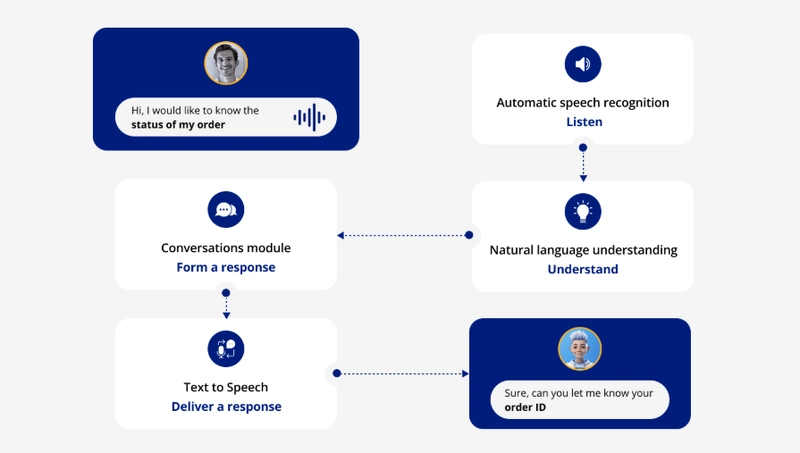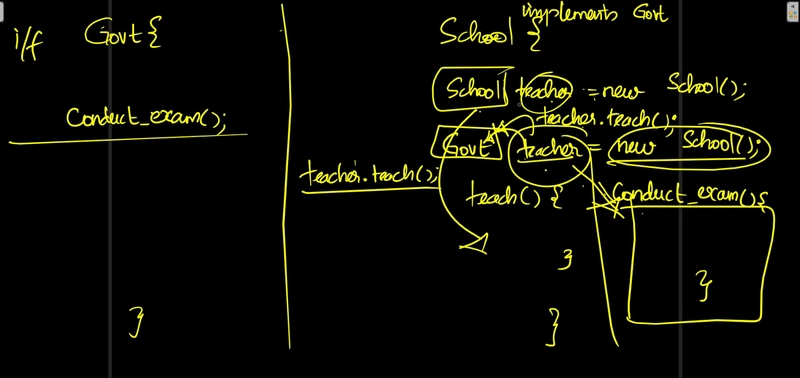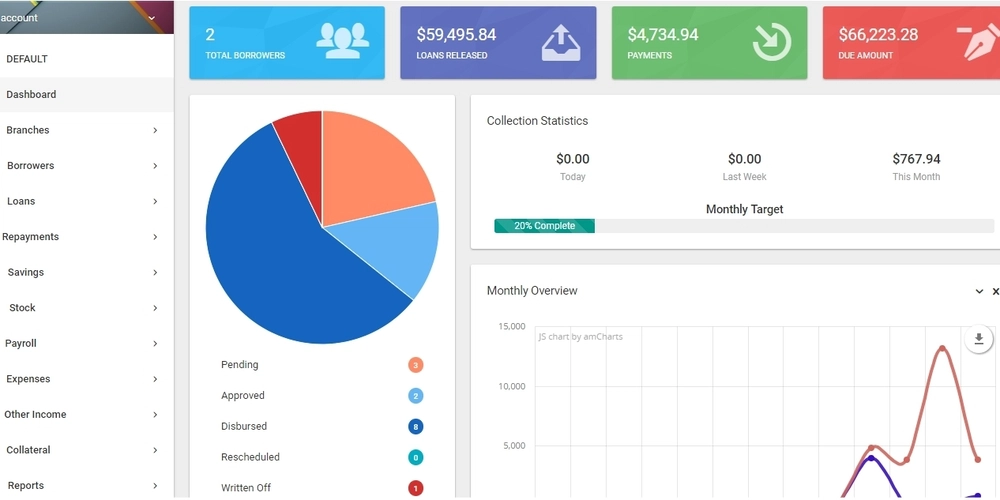Voice-Enabled Chatbots for Smarter Customer Engagement.
Imagine a world where customers can interact with businesses on voice commands alone. No typing. No more waiting around. Just a command or two, and the speech recognition chatbot understands, responds, and fixes problems with immediate effect. This is basically how voice chatbots are revolutionizing customer interactions by making them faster, totally natural, and extremely easy to engage with. Today, one of the key elements of daily life is voice technology, thanks to smart assistants like Alexa, Siri, and Google Assistant. It is reported that more than 48% of customers use voice search daily. Chatbot with voice recognition implements a seamless environment for customers to engage with businesses in a hands-free manner, leading to better customer satisfaction and engagement. Today, quick and effortless interaction is what customers expect. Informationally, traditional chatbots have gained considerable mileage toward enhancing service speed, but they still require manual user input. In contrast, voice assistant chatbot take it further by utilizing natural language processing (NLP) and AI-based speech recognition to communicate with the level of understanding and response of a human. This technology is defining the future of customer service, e-commerce, and user engagement. Voice chatbots keep operational processes simple and improve user experiences for their interaction-based services: answering inquiries, booking appointments, or even completing transactions. Hence, companies that capitalize on this incoming innovation have a great advantage, leading to faster response times and better customer relations. So, is your business ready for the future of voice-driven interactions? Let’s find out. ** Understanding Voice-Enabled Chatbots ** Voice chatbots use artificial intelligence and voice recognition to hear and recognize spoken commands. They allow hands-free, real-time interactions with both parties. By 2026, voice AI will drive $19.4 billion in transactions. They help in customer support bookings and sales at the same time making the experience faster and more natural than the traditional ways of text chatbots. ** Voice-Enabled Chatbots: How do they work? ** Voice-enabled chatbots use artificial intelligence to enable user interaction with companies via voice commands instead of text. Voice-enabled chatbot improves customer service by automating requests while giving the user a hands-free interactive experience. These are integrated into several platforms such as websites, mobile apps, smart speakers, and call centres offering multi-language support, real-time assistance, and conversations tailored to individual client needs via customer history and behaviour. This is how a voice chatbot works: Speech Recognition (ASR): The spoken words are converted into text using AI-based speech-to-text algorithms. Background noise is filtered, while speech clarity is enhanced for accurate transcription. Natural Language Processing (NLP): Analyzes user intent, sentiment, and context. NLP models such as BERT or GPT enable the chatbot to grasp different accents, slang, and the complexity of the query. AI-Powered Decisioning: Machine-learning algorithms evaluate input to extract relevant information and provide the chatbot with the most advantageous response. Advanced chatbots have pre-trained AI models that will detect what the user really wants. Text-to-Speech (TTS) Conversion: Using synthetic voice engines, like Google’s WaveNet or Amazon Polly, responses are further converted back into human-like speech. API and Backend Integrations: Chatbots hook into CRMs, databases, and third-party applications to pull in personalized user information and perform more complex requests. Continuous Learning and Adaptation: The chatbot improves over time using ML continually and refines its responses according to user interaction. ** Voice-Enabled Chatbots and Traditional Chatbots: How they Differ? ** Voice-enabled chatbots and traditional ones do the same thing with clients; however, the two differ in the way they typically use input to give results or responses. Traditional chatbots are based on NLP and text-based algorithms, while those integrated with voice use Automatic Speech Recognition, Text-to-Speech, and Speech Synthesis for voice communication. Below is a detailed comparison: ** The Role of Voice-Enabled Chatbots in Modern Business ** Voice chatbots are redefining business communications by rendering an effortless and hands-free support mechanism and automating customer interactions. Research indicates that 71% of consumers would rather use voice assistants for instantaneous responses. Here is how they help in modern business operations: Instant, Hands-Free Support: These voice chatbots, using Automatic Speech Recognition (ASR) and Natural Language Understanding (NLU), allow robots to convert and process a voice query into the same application in real time

Imagine a world where customers can interact with businesses on voice commands alone. No typing. No more waiting around. Just a command or two, and the speech recognition chatbot understands, responds, and fixes problems with immediate effect. This is basically how voice chatbots are revolutionizing customer interactions by making them faster, totally natural, and extremely easy to engage with.
Today, one of the key elements of daily life is voice technology, thanks to smart assistants like Alexa, Siri, and Google Assistant. It is reported that more than 48% of customers use voice search daily. Chatbot with voice recognition implements a seamless environment for customers to engage with businesses in a hands-free manner, leading to better customer satisfaction and engagement.
Today, quick and effortless interaction is what customers expect. Informationally, traditional chatbots have gained considerable mileage toward enhancing service speed, but they still require manual user input. In contrast, voice assistant chatbot take it further by utilizing natural language processing (NLP) and AI-based speech recognition to communicate with the level of understanding and response of a human. This technology is defining the future of customer service, e-commerce, and user engagement.
Voice chatbots keep operational processes simple and improve user experiences for their interaction-based services: answering inquiries, booking appointments, or even completing transactions. Hence, companies that capitalize on this incoming innovation have a great advantage, leading to faster response times and better customer relations. So, is your business ready for the future of voice-driven interactions? Let’s find out.
**
Understanding Voice-Enabled Chatbots
**
Voice chatbots use artificial intelligence and voice recognition to hear and recognize spoken commands. They allow hands-free, real-time interactions with both parties. By 2026, voice AI will drive $19.4 billion in transactions. They help in customer support bookings and sales at the same time making the experience faster and more natural than the traditional ways of text chatbots.
**
Voice-Enabled Chatbots: How do they work?
**
Voice-enabled chatbots use artificial intelligence to enable user interaction with companies via voice commands instead of text. Voice-enabled chatbot improves customer service by automating requests while giving the user a hands-free interactive experience. These are integrated into several platforms such as websites, mobile apps, smart speakers, and call centres offering multi-language support, real-time assistance, and conversations tailored to individual client needs via customer history and behaviour.
This is how a voice chatbot works:
- Speech Recognition (ASR): The spoken words are converted into text using AI-based speech-to-text algorithms. Background noise is filtered, while speech clarity is enhanced for accurate transcription.
- Natural Language Processing (NLP): Analyzes user intent, sentiment, and context. NLP models such as BERT or GPT enable the chatbot to grasp different accents, slang, and the complexity of the query.
- AI-Powered Decisioning: Machine-learning algorithms evaluate input to extract relevant information and provide the chatbot with the most advantageous response. Advanced chatbots have pre-trained AI models that will detect what the user really wants.
- Text-to-Speech (TTS) Conversion: Using synthetic voice engines, like Google’s WaveNet or Amazon Polly, responses are further converted back into human-like speech.
- API and Backend Integrations: Chatbots hook into CRMs, databases, and third-party applications to pull in personalized user information and perform more complex requests.
- Continuous Learning and Adaptation: The chatbot improves over time using ML continually and refines its responses according to user interaction.
**
Voice-Enabled Chatbots and Traditional Chatbots: How they Differ?
**
Voice-enabled chatbots and traditional ones do the same thing with clients; however, the two differ in the way they typically use input to give results or responses. Traditional chatbots are based on NLP and text-based algorithms, while those integrated with voice use Automatic Speech Recognition, Text-to-Speech, and Speech Synthesis for voice communication. Below is a detailed comparison:
**
The Role of Voice-Enabled Chatbots in Modern Business
**
Voice chatbots are redefining business communications by rendering an effortless and hands-free support mechanism and automating customer interactions. Research indicates that 71% of consumers would rather use voice assistants for instantaneous responses. Here is how they help in modern business operations:
- Instant, Hands-Free Support: These voice chatbots, using Automatic Speech Recognition (ASR) and Natural Language Understanding (NLU), allow robots to convert and process a voice query into the same application in real time and provide instant communication without any manual intervention.
- Automating Repetitive Tasks: These AI-powered chatbots require due human intervention by machine learning algorithms for FAQs, scheduling appointments, processing transactions, and call routing.
- Personalized Customer Experience: Sentiment analysis and context-aware AI build avatar technology that monitors user interaction, analyses emotion, and personalizes response depending on previous interactions.
- Seamless Integration: Using APIs and cloud-based services, voice chatbots link with CRM, ERP, and IoT devices so that data can flow in and out, thereby increasing operational efficiency.
- Enhanced Multilingual Support: Multimodal AI models and speech synthesis technologies (TTS - Text-to-Speech) allow the chatbot to converse in multiple languages and aid in global customer engagement.
- Data-Driven Insights: Artificial intelligence-enabled analytics tools such as speech-to-text transcription and behavioral analysis provide enterprises with the necessary tools to understand user patterns, increase chatbot accuracy, and enhance their service strategies. **
Why Voice-Enabled Chatbots Are the Future of Customer Interaction?
**
Read The Full Blog:-https://www.bitontree.com/blog/voice-enabled-chatbots









































































































































































![[The AI Show Episode 144]: ChatGPT’s New Memory, Shopify CEO’s Leaked “AI First” Memo, Google Cloud Next Releases, o3 and o4-mini Coming Soon & Llama 4’s Rocky Launch](https://www.marketingaiinstitute.com/hubfs/ep%20144%20cover.png)




























































































































![[DEALS] The All-in-One Microsoft Office Pro 2019 for Windows: Lifetime License + Windows 11 Pro Bundle (89% off) & Other Deals Up To 98% Off](https://www.javacodegeeks.com/wp-content/uploads/2012/12/jcg-logo.jpg)



























![Is this too much for a modular monolith system? [closed]](https://i.sstatic.net/pYL1nsfg.png)






















































































































_Andreas_Prott_Alamy.jpg?width=1280&auto=webp&quality=80&disable=upscale#)
































































































![What features do you get with Gemini Advanced? [April 2025]](https://i0.wp.com/9to5google.com/wp-content/uploads/sites/4/2024/02/gemini-advanced-cover.jpg?resize=1200%2C628&quality=82&strip=all&ssl=1)













![Apple Shares Official Trailer for 'Long Way Home' Starring Ewan McGregor and Charley Boorman [Video]](https://www.iclarified.com/images/news/97069/97069/97069-640.jpg)
![Apple Watch Series 10 Back On Sale for $299! [Lowest Price Ever]](https://www.iclarified.com/images/news/96657/96657/96657-640.jpg)
![EU Postpones Apple App Store Fines Amid Tariff Negotiations [Report]](https://www.iclarified.com/images/news/97068/97068/97068-640.jpg)
![Apple Slips to Fifth in China's Smartphone Market with 9% Decline [Report]](https://www.iclarified.com/images/news/97065/97065/97065-640.jpg)





































































































































